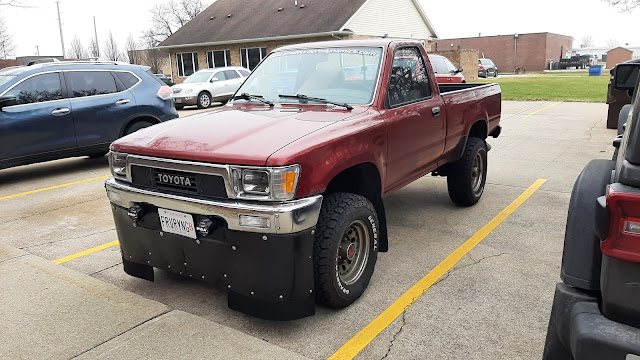I used to talk about aerodynamic modifications on my
cars—and remember, I had no idea if they worked or not because I had never tested
anything—using the word “should” a lot. “Removing the mirrors should be
reducing drag,” for example. “Adding this tail should make it a lot more
streamlined.” “Putting these lowering springs on should lower drag.”
“Taping vortex generators here should keep flow attached over this
panel.”
Banish this word, “should,” from your vocabulary whenever
you talk about aerodynamic modifications. The air doesn’t care about what you
think it should do, and you’re most likely wrong anyway.
 |
| This guy got it right. |
Mindset
That word, “should,” betrays a mindset of hoping that
your modifications work without testing them to see if they do or not.
If fear—of finding out they don’t work, of learning that you failed—is holding
you back, see if you can approach aerodynamic modification with a different
attitude. The Last Jedi had its problems, but it did have one good line:
“Failure, the greatest teacher is.” Failure is not a result, it’s a starting
point. I can’t say I look forward to failing, but I do welcome the opportunity
to learn something from it. Which I do, every time I fail.
For example, I fitted air curtain ducts ahead of the front
and rear wheels on my Prius before I learned how to test; “These should
speed the air up over the wheel openings and reduce drag,” I reasoned. Fast
forward several months: I measured the pressure change along the side of the
body, with and without the ducts in place. The front ducts, it turned out,
weren’t doing anything measurable—exactly the same pressure on the front
and rear doors with the ducts installed as without them. But the rears were;
there was a measurable increase in pressure on the side of the rear bumper
cover.
 |
| Version 1 on the left; version 2 on the right. |
So, back to the drawing board I went to make another
version. I fitted the newly-designed, larger front ducts to the car and went
out for a test drive; I immediately noticed that the front of the car was
dramatically more stable. I subsequently tested the car in crosswinds and
passing heavy trucks, with and without ducts, and measured the pressure
difference side-to-side in crosswinds; sure enough, there was a measurable
difference. These ducts were doing something cool, although it was not what I
had intended (and further testing showed no change in drag with or without
them—so in that sense, I had failed again!). I never would have discovered this
without failing.
Another example: last year I was reading an old Autospeed
article in which Julian Edgar reported taping vortex generators under the front
of a car to see if the air could be sped up there. He wrote that the car felt
more stable with the VGs in place than without. So I fabricated some VGs from
scrap metal sheet, taped them under my bumper, and went out for a drive. No
change. Absolutely no discernible difference in the car’s handling. Failure!
But ever since then, I’ve been thinking about other things I could experiment
with—for instance, a converging duct to accelerate the air under the car—that I
never would have had cause to come up with if I hadn’t tried something and
failed.
Could
Rather than using should, replace this word with could.
“Could” allows for the possibility that a change works or doesn’t, subject to
testing and measurement; it removes any theory-based expectation that may or
may not turn out to be real. “Could a tapered tail at the back of my car
reduce its drag?” “Could adding vortex generators at the top of the rear
window keep the flow attached on the trunk lid?” “Could blocking the
grill reduce drag enough to measure?”
 |
| A grill block undergoing testing. |
All scientific progress has been made this way: by finding
out what happens when something is done or changed and then figuring out
why it happened. Observations of physical phenomena are the foundation of the
scientific method; observation precedes hypothesis and theory. So don’t get
that turned around! Especially with something as complex as aerodynamics, where
air behaves non-intuitively and cannot be predicted with any certainty, you cannot
proceed from theory to application without testing. Go the other
way—application and observation first, then theory. Tape tufts to your car and
observe where the flow separates; then make a change and observe the effect on
the tufts. Measure surface pressure somewhere on your car; then make a change
and measure in the same spot again to see what effect it has. Record a throttle-limited top speed; then make a change and see if it goes up or down.
Along with that, don’t go online and BS about your modifications
working when you haven’t ever tested them and are relying solely on a “should”
mentality, guessing and hoping. I did this for years, and it was only later
that I realized it is incredibly dishonest. If something you built works, you
should have test results to back that up. We have a variety of methods
available to measure things on the road; use them!
 |
| Because testing showed it works--reducing drag around 4%--I built a permanent version. No "should," no guesswork. |







Comments
Post a Comment